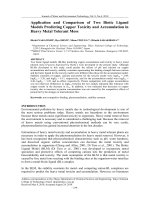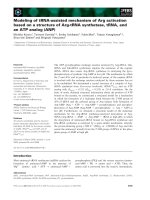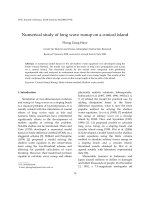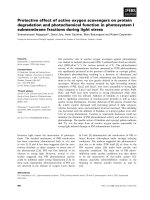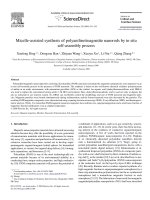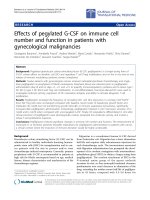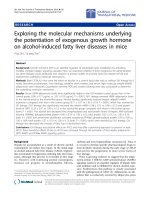- Trang chủ >>
- Khoa Học Tự Nhiên >>
- Vật lý
STRUCTURES OF ADSORBED HALIDE ANIONS ON a COPPER ELECTRODE STUDIED BY IN SITU SCANNING TUNNELING MICROSCOPY
Bạn đang xem bản rút gọn của tài liệu. Xem và tải ngay bản đầy đủ của tài liệu tại đây (8.98 MB, 9 trang )
Proc. Natl. Conf. Theor. Phys. 36 (2011), pp. 239-247
STRUCTURES OF ADSORBED HALIDE ANIONS ON A COPPER
ELECTRODE STUDIED BY IN SITU SCANNING TUNNELING
MICROSCOPY
PHAN THANH HAI
Institute of Physical and Theoretical Chemistry, University of Bonn, Wegelerstr.12,
53115 Bonn, Germany
Department of Physics, Quynhon University, 170 An Duong Vuong, Quynhon, Vietnam
DOAN MINH THUY
Department of Physics, Quynhon University, 170 An Duong Vuong, Quynhon, Vietnam
WANDELT KLAUS
Institute of Physical and Theoretical Chemistry, University of Bonn, Wegelerstr.12,
53115 Bonn, Germany
Abstract. The structures of adsorbed halide monolayers, e.g. chloride, iodide, on a Cu(100)
electrode have been investigated by a combination of cyclic voltammetry (CV) and electrochemical
scanning tunneling microscopy (EC-STM). The potential range of the copper electrode in electrolytes is limited by two chemical reactions, (i) the oxidative copper dissolution reaction (CDR)
at the anodic limit and (ii) the reductive hydrogen evolution reaction (HER) at the cathodic limit.
While a featureless CV curve is characteristic for this electrode surface in pure hydrochloric acid,
drastic changes in the CV curves are observed in the iodide containing solutions, indicating the
formation of a two-dimensional CuI film. While chloride anions form a simple c(2×2) structure on
the Cu(100) electrode, an electrocompressible c(p × 2) structure of adsorbed iodide is found, which
at anodic potentials at the onset of copper dissolution transforms into the two-dimensional CuI
compound. Based on these informations structure models are proposed for the various adsorbate
layers which could serve as input in theoretical simulations.
I. INTRODUCTION
In recent decades copper has attracted great attention because of its importance as
a connecting material for integrated circuits in the silicon chip technology replacing the
traditional vacuum deposited aluminum based interconnects [1, 2]. It is well known that
the damascene copper electroplating process invented in the early 1990s at IBM [1] has
changed significantly the state-of-the-art chip fabrication. A detailed understanding of the
relevant interfacial properties of those devices at the nanometer-scale is still required since
the control of the copper-electrolyte interfaces with or without external potential is still
a particular challenge. Accordingly, a detailed comprehension from the theoretical and
experimental points of view on an atomic scale of the role of additives on copper plating
[3, 4, 5, 6], copper corrosion, corrosion inhibition by organic molecules [7, 8], oxidation,
anodic dissolution [9, 10], and passive film formation [11, 12, 13, 14, 15] is, hence, of
fundamental interest.
240
PHAN THANH HAI, DOAN MINH THUY, WANDELT KLAUS
Experimentally, scanning tunneling microscopy (STM) invented in the early 1980s
by Binnig and Rohrer [16, 17, 18] is a powerful tool for the investigation of atomic scale
surface structures formed in UHV environments. Shortly after, for the first time by Sonnenfeld and Hansma in 1986 [19], the in situ visualization of surface dynamics and thermodynamical processes, e.g. corrosion, electrodeposition, adsorption, as well as surface
modification and passivation, via STM measurements in electrochemical media has resulted in a radical change in surface electrochemistry. Later a few other research groups
have come up with further developments of electrochemical STMs (EC-STM) in order to
gain better research results. Exemplarily, a home-built EC-STM system introduced by
Wilms et al. in 1999 [20] has been applied since then by the Wandelt group, University
of Bonn, very successfully. At presence, several other research groups worldwide are using
this equipment from Bonn for their studies, such as the groups of Broekmann (Uni. Bern)
[21], De Feyter (Uni. Leuven) [22], Krupsky (Uni. Wroclaw), Nowakowski (Pol. Academy
of Sciences, Warsaw), Tsay (University of Technology, Taipei), etc.,..
In the present contribution, the interaction of chloride and iodide anions with the
surface of a Cu(100) electrode is studied with this EC-STM. The high resolution data
are presented here and discussed in detail. While chloride forms a highly ordered c(2 × 2)
structure within the double layer regime of the copper potential window, iodide adsorption
leads to a variety of incommensurate adlayers as well as the formation of a two dimensional
copper iodide compound film.
II. EXPERIMENTAL SETUP
For all solutions, high purity water (Milli-Q purification system, conductivity >
18 M Ω.cm, TOC < 4 ppb), halides purchased from Aldrich-Sigma (Germany) and other
reagent grade chemicals were used. All electrolyte solutions were purged with oxygen free
argon gas for several hours before use. The potential of the copper electrode is referenced
to a reversible hydrogen electrode (RHE) while a Pt wire is employed as counter-electrode.
In order to guarantee a reproducibly smooth surface even after several electropolishing cycles, a surface orientation of less than 0.5o off the Cu(100) plane was required
(MaTechCompany, Juelich, Germany). The Cu(100) sample was electropolished before
each STM experiment in order to remove the native oxide film formed in air and contaminations on the surface by immersing the electrode surface into 50% orthophosphoric
acid. Subsequently, an anodic potential of 2V was applied between the copper electrode
and a platinum foil for about 20 to 40s. After this etching procedure the copper surface
was rinsed with degassed 10 mM hydrochloric acid solution and mounted into the electrochemical cell of the home-built electrochemical scanning tunneling microscopy (EC-STM)
described in detail by Wilms et al. [20]
In order to eliminate the influence of oxygen as well as acoustic and electromagnetic
interferences from all cyclic voltammogram (CV) and EC-STM measurements, the whole
EC-STM system is housed within a sealed aluminium chamber with electrical and liquid
feed-throughs and filled with suprapure argon gas. Initial CV and STM measurements were
performed in HCl electrolyte in order to investigate the electrochemistry and adsorbate
structure of chloride anions on the Cu(100) electrode. For the adsorption of iodide anions
on the same substrate surface the supporting electrolyte (10 mM HCl) was replaced by
STRUCTURES OF ADSORBED HALIDE ANIONS ON A COPPER ELECTRODE STUDIED BY ... 241
a solution containing iodide (10 mM HCl + 1 mM KI) at a potential of −100 mV vs
RHE to avoid 3D CuI formation from solution (see below).
The tunneling tips used in our experiments were electrochemically etched from a
0.25 mm tungsten wire in 2M KOH solution and subsequently coated by passing the tip
through a hot-melt glue film.
Fig. 1. Cyclic voltammograms of a Cu(100) electrode in pure hydrochloric acid
(dash back curve) and in iodide containing HCl electrolyte (red curve).
III. RESULTS AND DISCUSSION
III.1. Electrochemistry
The electrochemistry of the Cu(100) electrode in the electrolytes containing chloride
and iodide anions, firstly, has been investigated by mean of cyclic voltametry (CV) as
shown in Fig. 1. The potential range of the copper electrode in electrolytes is limited by
two chemical reactions, (i) the oxidative copper dissolution reaction (CDR) at the anodic
limit and (ii) the reductive hydrogen evolution reaction (HER) at the cathodic limit. A
featureless CV curve (dash-black curve) is characteristic for Cu(100) in pure hydrochloric
acid showing a cathodic peak (actually an unresolved double-peak) at +130 mV assigned to
the redeposition of dissolved copper cations from solution following the sequence: Cu2+ →
Cu+ → Cuo [23-24]. In comparison with this CV, a drastic change in the CV curve is
observed once the Cu(100) is brought into contact with the iodide anions containing
solution (red curve). The most striking deviation from the pure supporting electrolyte
CV, in fact, is seen in the anodic potential regime. As a consequence, some characteristic
features are visible in the anodic scan direction labeled P1 = +90 mV and P2 = +141 mV ,
respectively. These peaks are from the electrochemical point of view assigned to the
formation of new phases from iodide anions in the solution and the cuprous and/or cupric
cations from the copper dissolution at positive potentials. As a result, a 2D CuI film at
P1 and 3D CuI clusters at P2 are formed ontop of an adsorbed iodide interlayer according
to the following equations [23, 24, 25]
Cu+ + I − ←→ CuImonomer ,
(1)
242
PHAN THANH HAI, DOAN MINH THUY, WANDELT KLAUS
nCuI ←→ (CuI)n (f ilm) .
(2)
In the reverse scan several cathodic current waves emerge relating to complicated surface
′
′
processes. The two first bumps, i.e. the features labeled P1 = +45 mV and P3 = −10 mV
′
are formed due to the dissolution of the 2D CuI film, the highly intensive peak P2 at
E = −190 mV arises from the reduction of the 3D CuI clusters which precipitated from
the solution phase onto the copper surface following a process described by the following
[23]:
2Cu2+ + 4I − ←→ 2CuI ↓ +I2 ↓ .
(3)
The molecular iodine formed in (3), however, is not stable under the current conditions,
and, therefore, should be electroreduced to iodide anions according to [24]:
I2 + 2e− −→ 2I − (electroreduction) .
(4)
The same results and reasonable explanations have been reported by Inukai et al. [26] who
observed similar CV results of Cu(100) exposed to an iodide containing perchloric acid,
and by Broekmann et al. [23] who used the same working electrolyte as in the present
work.
III.2. Morphology and atomic structure of chloride modified Cu(100) electrode
It is well known that chloride anions
√
√are adsorbing strongly on a Cu(100) electrode
in order to form a highly ordered ( 2 × 2)R45o superstructure within the whole potential range of the copper potential window that can be investigated by in situ STM
measurements. Equivalently, this structure can be also described by a c(2 × 2) unit cell.
Fig. 2 depicts the surface morphology of the Cu(100) electrode exposed to hydrochloric
acid solution at a potential of +20 mV vs HRE. The STM results show that the chloride
adsorbate induces a significant change in the surface morphology of the Cu(100) electrode
due to a strong substrate-adsorbate interaction leading to a new topographic equilibrium
of the surface stabilized by chloride anions at copper steps aligned along the [001] and [010]
directions [27, 28]. In order to precisely clarify the arrangement of the chloride anions at an
atomic scale high resolution STM images are shown in Fig. 3. Obviously, the chloride anions oriented parallel to the step-edges result in step edges which appear perfectly straight
and atomically smooth (Fig. 2 and Fig. 3a) indicating that defects such as kink sites are
drastically disfavored. The detailed surface structure of the chloride terminated
√
√Cu(100)
electrode on an atomic level with the typical quadratic features of the ( 2 × 2)R45o
superstructure and a corresponding hard sphere model depicting two successive layers and
the unit cell are presented in Fig. 3b and Fig. 3c. The lattice constants calculated are
times longer than the nearest neighbor distance of copper atoms on the Cu(100) surface,
namely 3.6 ± 0.1 ˚
A[27].
III.3. Structural characterization of iodide adlayer on the Cu(100) electrode
An electrolyte replacement procedure from pure to iodide containing hydrochloric
acid as mentioned in the experimental section immediately results in the formation of a new
laterally ordered phase i.e. an iodide adlayer as described in Fig. 4. Unlike the c(2×2)−Cl
structure, iodide anions form a distorted structure which is solely commensurate along the
STRUCTURES OF ADSORBED HALIDE ANIONS ON A COPPER ELECTRODE STUDIED BY ... 243
Fig. 2. Morphologic feature of a chloride adlayer on a Cu(100) electrode surface,
83.23 nm × 83.23 nm, U bias = +168 mV, It = 0.1 nA, E = +20 mV .
Fig. 3. High resolution STM images of chloride covered Cu(100) electrode surface:
a) typical copper steps preferentially aligned parallel to the close packed chloride
rows, 9.92 nm × 9.92 nm, U bias = +40 mV, It = 5 nA, E = +20 mV ; b)
c(2 × 2) − Cl structure on Cu(100), 4.37 nm × 4.37 nm, U bias = +20 mV, It =
2.5 nA, E = −10 mV ; c) structural model of the c(2 × 2) − Cl adlayer.
< 011 > substrate directions [29, 30, 31] leading to a one dimensional height modulation
as shown in Figs. 4a-b. Obviously, this structure derives from the quadratic chloride
structure on the Cu(100) substrate by expanding it parallel to only one of the original
unit cell vectors. As a result, the iodide unit cell is described by a c(p × 2) − I notation
with the p value varying proportionally to the electrode potential in terms of a so called
electro-expansion/-compression process. A possible structure model of the c(p × 2) − I
lattice is presented in Fig.4c with the surface coverage being about 0.4 M L and a nearest
neighbor distance (NND) of 4.1 ˚
A at the given potential [23].
An advantage of STM measurements in electrochemical environment compared to
those in UHV is the additional control of the surface processes by adjusting the electrode
potential. In the present study, a series of EC-STM images has been recorded at the same
surface area with a continuously positive adjustment of the electrode potential. As can
be seen in Fig. 5, a local dissolution of copper material is preferentially taking place at
step-edges when the electrode potential is swept from E = +90 mV to E = +120 mV vs
244
PHAN THANH HAI, DOAN MINH THUY, WANDELT KLAUS
Fig. 4. Atomic structure and surface morphology of the iodide modified Cu(100)
electrode surface: a) height modulation of the iodide structure, 28.81 nm ×
28.81 nm, U bias = +278 mV, It = 0.15 nA, E = +20 mV ; b) atomic structure of the c(p × 2) − I layer, U bias = +20 mV, It = 1.2 nA, E = 0 mV , c)
structure model of c(p × 2) − I adlayer, p varies with the electrode potential.
Fig. 5. Simultaneously occurring copper dissolution and 2D CuI growth on a
Cu(100) electrode surface, 72.02 nm × 72.02 nm; a) adsorbed iodide mono-film
layer (phase I), U bias = 112 mV, It = 0.3 nA, E = +90 mV ; b) mixed structure
between iodide adlayer and CuI film phase II, U bias = 112 mV, It = 0.3 nA, E =
+120 mV ; c) fully developed CuI film on Cu(100) surface, U bias = 112 mV, It =
0.3 nA, E = +135 mV .
RHE (Figs. 5a-b) as marked by white arrows. Astonishingly, simultaneously to the local
removal of copper from the step-edges one can observe the growth of a new ordered stripe
structure ontop of the c(p × 2) − I interlayer (Fig. 5b) indicating that both processes i.e.
copper dissolution and stripe formation are correlated with each other. A full monolayer
of the new stripe phase rapidly covers the entire electrode surface as presented in Fig. 5c.
Obviously, the lateral structure of this new overlayer significantly differs from the well
known c(p × 2) − I phase on the Cu(100) substrate. Based on the observed consumption
of copper this new phase has been assigned to a 2D film growing ontop of the iodide
precovered Cu(100) [24]. To accentuate the new structure of this film a close-up view at
the atomic level is shown at the initial and final stage of the film formation in Figs. 6-8,
respectively. The obtained STM results suggest that the initially formed phase is not
stable at any potential and must, therefore, be considered as a metastable phase denoted
by phase II (Fig. 6). Large scale and high resolution figures of this initial phase II are
described in Fig. 7. The iodide anions are arranged in a stripe pattern with a height
modulation and periodicity calculated to be about 0.07 ± 0.01 nm and L = 3.75 ± 0.1 nm,
respectively. Nevertheless, after the formation, this metastable phase II is immediately
transformed into a more permanent pattern within an actually narrow potential window
between +120 mV to +140 mV , namely the so-called phase III. The surface dynamics
STRUCTURES OF ADSORBED HALIDE ANIONS ON A COPPER ELECTRODE STUDIED BY ... 245
of this phase transition is presented in Fig. 8. The new phase III shows also a stripe
structure but with a significantly lower height modulation and is rotated with respect
Fig. 6. Typical large scale STM image of CuI phases with different height corrugations formed on the iodide modified Cu(100) electrode surface, 72.02 nm ×
72.02 nm, U bias = 190 mV, It = 0.4 nA, E = +127 mV .
Fig. 7. Medium scale and high resolution STM images of the metastable CuI
phase (phase II): a) 28.8 nm × 28.81 nm, U bias = 210 mV, It = 0.5 nA, E =
+127 mV ; b) 12.83 nm×12.83 nm, U bias = 112 mV, It = 0.3 nA, E = +130 mV .
Fig. 8. Surface dynamics of the phase transition from metastable phase (phase II)
to stable pattern (phase III): 28.82 nm × 28.81nm, U bias = 200 mV, It = 0.6 nA;
a) E = +132 mV ; b) E = +135 mV .
to phase II by an angle of 10o (Fig. 8b). Unlike phase II two different stripe widths are
formed in phase III, namely L1 = 1.69 ± 0.1 nm and L2 = 2.18 ± 0.1 nm, respectively,
as seen in Fig. 9a. The same ECSTM results have already been obtained by Broekmann
et al. [23] and Hai et al. [32], but no definitive structure models have been presented
246
PHAN THANH HAI, DOAN MINH THUY, WANDELT KLAUS
Fig. 9. Atomic structure of the stable CuI film (phase III): a) 12.76 nm×12.76 nm
and b) 7.09 nm × 7.09 nm, U bias = 140 mV, It = 0.3 nA, E = +138 mV (note
very shallow depression in the middle of the broad stripes marked by white arrows).
so far explaining the structural details and differences of both phases. In any case, the
unidirectional modulation across the stripes is related to a lattice mismatch between the
2D CuI film and the substrate underneath.
The high resolution images of CuI phase III in Fig.9 show an almost ideal hexagonal
symmetry with a NND of 0.47 ± 0.02 nm. Moreover, the stripe propagation directions
are rotated by an angle of 6 ± 1o with respect to the close-packed rows (Fig. 9b) of atoms
visible within the stripes. On average the narrow stripes are four atoms wide while the
broad stripes are 7 atomic rows broad. It is suggested that the broad stripe are actually
two joint narrow stripes as suggested by a very shallow depression in the middle of the
broad stripes (white arrows in Fig. 9a).
Sweeping the electrode potential more positively the copper dissolution is first accelerated but then drastically slowed down when the potential is over E = +135 mV . As
a result, 3D CuI clusters appear on the copper surface with the result that the surface
imaging becomes more and more difficult due to the low conductivity of bulky CuI cluster
(STM figure not shown in this context).
IV. CONCLUSION
The electrochemical behaviors of a Cu(100) electrode in pure dilute HCl and iodide containing HCl solutions was investigated by in situ STM. Halide anions adsorb
with typical structures on the Cu(100) electrode surface. While a c(2 × 2) structure is
found for the chloride adlayer, variable potential dependent structures are observed in the
iodide adsorption case. A distorted c(2 × 2) structure or a so-called c(p × 2) − I, with
p varying proportionally with the electrode potential, was found at potentials less than
E = +90 mV vs RHE. In contrast, new phases were indentified in the potential range from
+120 mV to +140 mV where copper dissolution taken place and a CuI film compound
is formed. Ultimately, an ideal hexagonal 2D CuI structure (phase III) is stably formed
after overcoming a pseudo hexagonal pattern (phase II) at the initial stage of the new
phase formation.
ACKNOWLEDGMENT
The financial support by the Deutsche Forschungsgemeinschaft (DFG) through the
SFB 624 project is gratefully acknowledged.
STRUCTURES OF ADSORBED HALIDE ANIONS ON A COPPER ELECTRODE STUDIED BY ... 247
REFERENCES
[1] P. C. Andriacos, C. Uzoh, J. O. Ducovic, J. Horcans, H. Deligianni, IBM J. Res. Dev. 42 (1998) 567.
[2] L. Arnaud, G. Tartavel, T. Berger, D. Mariolle, Y. Gobil, I. Touet, Microelectron. Reliab. 40 (2000)
1295.
[3] K. Kondo, N. Yamakawa, Z. Tanaka, K. Hayashi, J. Electroanal. Chem. 559 (2003) 137.
[4] J. J. Kelly, A. C. West, J. Electrochem. Soc. 145 (1998) 3472.
[5] J. J. Kelly, A. C. West, J. Electrochem. Soc. 145 (1998) 3477.
[6] J. J. Kelly, C. Tian, A. C. West, J. Electrochem. Soc. 146 (1999) 2540.
[7] M. R. Vogt, R. J. Nichols, O. M. Magnussen, R. J. Behm, J. Phys. Chem. B 102 (1998) 5859.
[8] O. M. Magnussen, M. R. Vogt, J. Scherer, A. Lachenwitzer, R. Behm, J. Mater Corros. 49 (1998)
169.
[9] D. W. Suggs, A. J Bard, J. Phys. Chem. 99 (1995) 8349.
[10] M. R. Vogt, A. Lachenwitzer, O. M. Magnussen, R. Behm, J. Surf. Sci. 399 (1998) 49.
[11] V. Maurice, H. H. Strehblow, P. Marcus, J. Electrochem. Soc. 146 (1999) 524.
[12] V. Maurice, H. H. Strehblow, P. Marcus, J. Surf. Sci. 458 (2000) 185.
[13] H. H. Strehblow, V. Maurice, P. Marcus, Electrochim. Acta 46 (2001) 3755.
[14] J. Kunze, V. Maurice, L. H. Klein, H. H. Strehblow, P. Marcus, J. Electroanal. Chem. 113 (2003)
554.
[15] J. Kunze, V. Maurice, L. H. Klein, H. H. Strehblow, P. Marcus, Corros. Sci. 46 (2004) 245.
[16] G. Binnig, H. Rohrer, Surf. Sci. 126 (1983) 236.
[17] G. Binnig, H. Rohrer, C. Gerber, E. Weibel, Appl. Phys. Lett. 40 (1982) 178.
[18] G. Binnig, H. Rohrer, Scientific American 253 (1985) 50.
[19] R. Sonnenfeld, P. K. Hansma, Science 232 (1986) 211.
[20] M. Wilms, M. Kruft, G. Bermes, K. Wandelt, Rev. Sci. 1999. Instr. 70 (1999) 3641.
[21] P. Broekmann, A. Fluegel, C. Emnet, M. Arnold, C. Roeger-Goepfert, A. Wagner, N.T.M. Hai, D.
Mayer, Electrochim. Acta 56 (2011) 4724.
[22] N. T. M. Hai, S. Furukawa, T. Vosch, S. De Feyter, P. Broekmann, K. Wandelt, Phys. Chem. Chem.
Phys. 11 (2009) 5422.
[23] P. Broekmann, N.T.M. Hai, and K. Wandelt, J. Appl. Elect. Chem., 36 (2006) 1241.
[24] N. T. M. Hai, S. Huemann, R. Hunger, W. Jaegermann, K. Wandelt, P. Broekmann, J. Phys. Chem.
C 111 (2007) 14768.
[25] P. Broekmann, N. T. M. Hai, K. Wandelt, Surf. Sci. 600 (2006) 3971.
[26] J. Inukai, Y. Osawa, K. Itaya, J. Phys. Chem. B 102 (1998) 10034.
[27] S. Huemann, N. T. M. Hai, P. Broekmann, K. Wandelt, J. Phys. Chem. B 110 (2006) 24955.
[28] T. H. Phan, K. Wandelt, unpublished
[29] P. Broekmann, A. Spaenig, A. Hommes, K. Wandelt, Surf. Sci. 517 (2002) 123.
[30] A. Hommes, A. Spaenig, P. Broekmann, K. Wandelt, Surf. Sci. 547 (2003) 239.
[31] T. H. Phan, K. Wandelt, unpublished
[32] N. T. M. Hai, PhD dissertation (2007), Born.
Received 30-09-2011.
